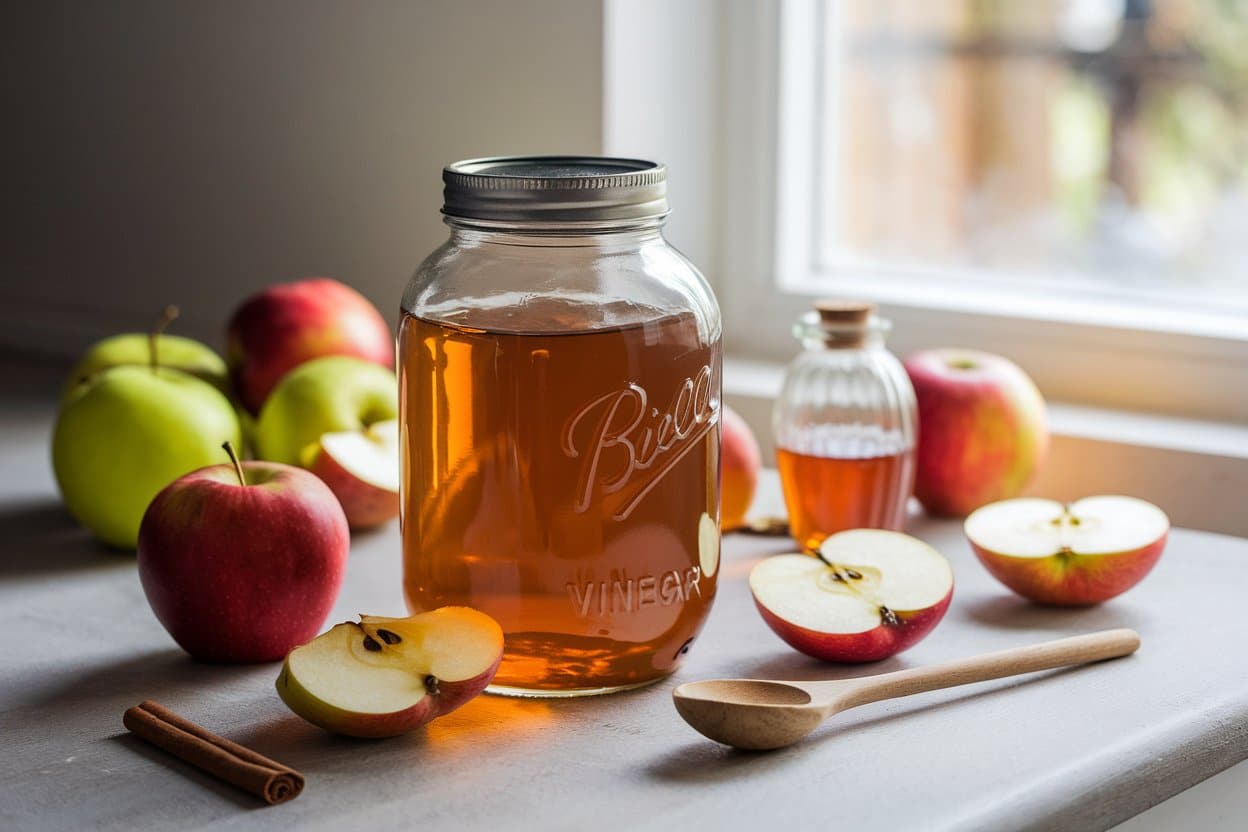Whether juggling work, parenting, or studies, quick and healthy meal prep can transform your energy levels and support long-term wellness goals. One underrated star of clean eating? Apple cider vinegar Recipe is a gut-friendly ingredient that can boost digestion, regulate blood sugar, and even aid weight management.
In this guide, you’ll learn:
- How to make your apple cider vinegar from scratch
- Balanced make-ahead meal prep ideas
- Simple, energy-boosting recipes
- Hydrating drinks to complement your plan
Let’s dive in and revitalize your wellness routine the smart way.
Homemade Apple Cider Vinegar Recipe
Apple cider vinegar is incredibly simple to make and requires minimal ingredients.
Ingredients:
- Apple scraps (peels, cores – from 6–8 apples)
- 2 tablespoons of organic sugar or raw honey
- Filtered water (enough to submerge apples)
- A wide-mouth glass jar
- Cheesecloth or breathable fabric & rubber band
 Instructions:
Instructions:
- Fill your jar with the apple scraps.
- Mix sugar/honey with water and pour it over the apples until fully covered.
- Cover the jar with cheesecloth and secure with a rubber band.
- Store in a warm, dark place for 3–4 weeks, stirring every few days.
- Strain out the apple solids and ferment for another 3–4 weeks until it smells tangy.
Nutritional Benefits:
- Probiotics to support gut health
- Acetic acid for blood sugar control
- Antioxidants from apple skins and peels
Pro Tip: Use ACV as a salad dressing base or dilute 1 tbsp in water for a morning detox drink.
Balanced Meal Prep Ideas with Apple Cider Vinegar Touches
Make-Ahead Breakfasts (Energy Boosting)
1. Apple Cinnamon Overnight Oats
- Rolled oats, chia seeds, almond milk, chopped apples, cinnamon, and a drizzle of ACV
- Benefits: Sustained energy, fiber, and gut health support
- Time-saving tip: Prep three jars on Sunday night for the workweek.
2. ACV Morning Elixir Smoothie
- 1 banana, 1 tbsp ACV, handful of spinach, coconut water, 1 tsp honey
- Hydration + blood sugar balance in one glass
High-Protein Lunches
1. ACV Chickpea Power Salad
- Chickpeas, cucumber, red onion, cherry tomatoes, parsley
- Dressing: olive oil, lemon, and 1 tsp ACV
- Macros: 22g protein, 12g fiber per serving
2. Grilled Chicken Quinoa Bowl
- Grilled chicken breast, quinoa, roasted sweet potatoes, kale
- ACV-honey-mustard dressing
- Meal prep tip: Double-batch chicken and grains for 3+ days of lunches.
Easy Dinners for Weight Management
1. Stir-Fried Veggie & Tofu Rice
- Brown rice, broccoli, bell peppers, tofu
- Sauce: low-sodium tamari, garlic, ginger, ACV
- Calorie smart + satisfying
2. Zucchini Noodles with ACV-Pesto
- Spiralized zucchini, cherry tomatoes, basil-pine nut pesto with ACV twist
- Light, low-carb, and refreshing
Hydrating Drinks & Smoothies to Complement Meal Prep
 1. Gut-Friendly ACV Lemonade
1. Gut-Friendly ACV Lemonade
- 2 tbsp ACV, juice of 1 lemon, water, mint leaves, a dash of stevia
- Keeps you refreshed and supports digestion
2. Berry-Kefir Smoothie
- Kefir (probiotic-rich), frozen berries, flaxseed, a splash of ACV
- Rich in gut-friendly bacteria + antioxidants
3. Green Electrolyte Cooler
- Coconut water, cucumber, lime juice, 1 tsp ACV
- Ideal post-workout or hot afternoons
Clean Eating on a Budget: Smart Shopping Tips
- Buy in bulk: Grains, oats, and legumes
- Prep seasonal produce: Cheaper and fresher
- Use scraps: Apple cores and peels are perfect for homemade ACV
- Meal plan weekly: Saves both money and stress
Meal Prep for Beginners: Tips to Succeed
- Start small: Prep 1–2 meals a day to build consistency
- Use clear containers: They help with portion control
- Label everything: Reduces waste and keeps you organized
- Stay flexible: Mix and match grains, proteins, and veggies
Final Thoughts
From gut-loving apple cider vinegar to balanced, budget-friendly meals, taking small, consistent steps can transform your health routine. Whether meal prepping overnight oats or sipping on an ACV electrolyte drink, the key is to fuel your body intentionally, not ideally.
Frequently Asked Questions (FAQs)
How often should I consume apple cider vinegar?
1–2 tablespoons a day, diluted in water or used in food, is considered safe for most people.
Can I drink ACV on an empty stomach?
Yes, but always dilute it. Straight ACV may harm tooth enamel or cause stomach discomfort.
How long does homemade ACV last?
Up to a year when stored in a cool, dark place. Once opened, refrigerate to prolong freshness.


 Instructions:
Instructions: 1. Gut-Friendly ACV Lemonade
1. Gut-Friendly ACV Lemonade














